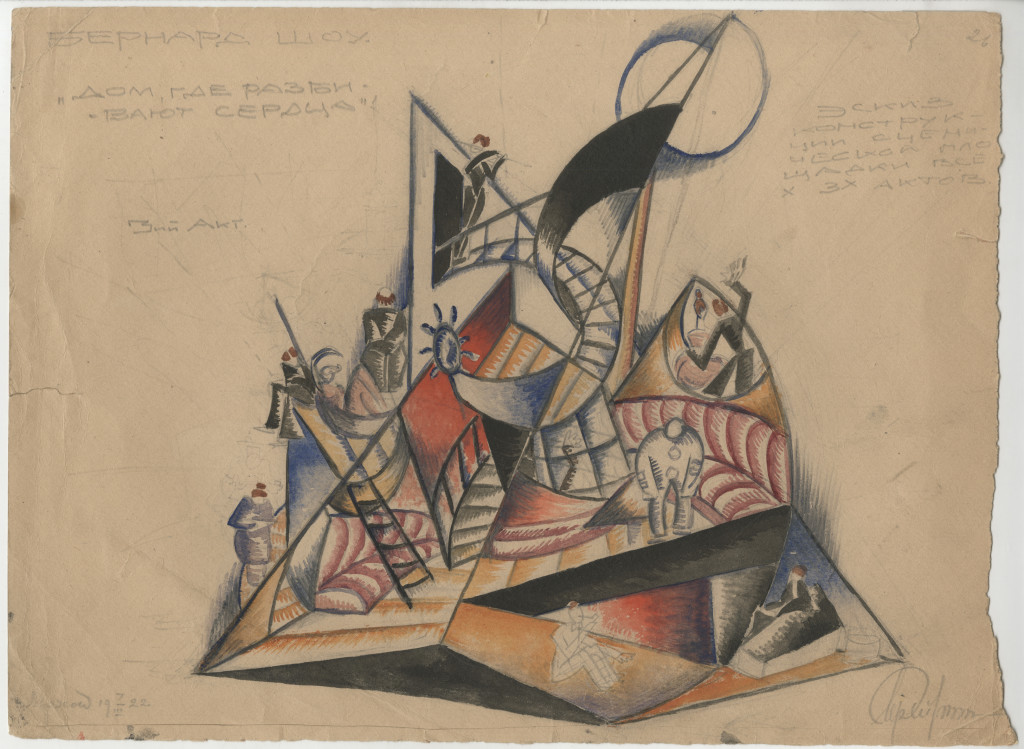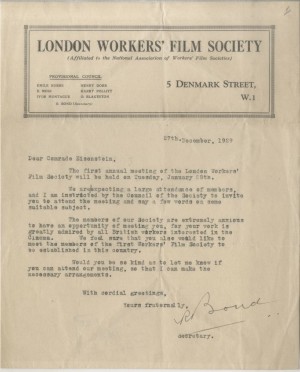【reclame erotice】
Unexpected Eisenstein
Look

Sergei Eisenstein, Set design for act 3 of Heartbreak House(unrealized), 1922, paper, pencil, ink and watercolor on paper. ©Russian State Archive of Literature and Art, Moscow

Letter from the London Workers’ Film Society to ‘Comrade Eisenstein’, December 27, 1929. ©Russian State Archive of Literature and Art, Moscow
“Seryozhenka learned English quickly and became familiar with the literature read by English children,” writes Marie Seton, Eisenstein’s one-time travelling companion, in her 1952 biography. As a child of affluent parents in Riga, Eisenstein wrote poetry in English, conversed in the language with his governess, read Dickens and Edward Lear, graduated to Rudyard Kipling, Lewis Carroll, and Oscar Wilde. The British establishment, and its heroes, fascinated him. Arthur Conan Doyle’s Sherlock Holmes novels had become a huge success in Russia, and Eisenstein was a longtime fan. It turns up in the archives: in 1922, while he was still a theatre director in Moscow, he designed costumes for a fantasy amalgam of two fictional sleuths, Holmes and the dime novel private detective Nick Carter. In 1934, two years before Stalin’s Great Terror, the director, a pathological bibliophile, ordered a copy of Vincent Starrett’s The Private Life of Sherlock Holmes, a blend of literary critique and historical analysis, from a British bookshop.
Sergei Eisenstein, preparatory drawing for Ivan the Terrible, part 3 (unrealized), 1942, pencil on paper. ©Russian State Archive of Literature and Art, Moscow
Eisenstein’s writing extensively references the deductions of detective fiction and dissects it to understand the mechanics of art. “In literature, we also find examples of the physical assembly of a person or an event out of fragments,” he wrote in one essay upon his return to Russia. He describes Holmesian logic as having “Dionysian” intensity, says Holmes’s ability to pick out clues is akin to the ability to “select at a moment’s notice an isolated detail in close-up.” “Sherlock Holmes for him was the ideal example to how you can bring your intuitive sensual comprehension of the world, together with your rational knowledge,” said Eisenstein biographer Oksana Bulgakowa in a telephone interview. Bulgakowa is currently translating a section of Eisenstein’s writing on detective fiction and said the director was especially interested in “pre-logical thinking,” borrowing the term from French anthropologist Lucien Lévy-Bruhl. “He tried to explain that novels such as Sherlock Holmes show us the evolution of our system of thinking,” she added. “We first go through the pre-logical, sensual analysis of spatial connections and then we discover the abstract, the cause and effect connections that defined our rational mind.”
Sergei Eisenstein, Thoughts on Music, 1938, pencil on paper. ©Russian State Archive of Literature and Art, Moscow
Because of the scattergun nature of his memoirs and theory, structured like a modernist text and incomplete, we don’t know for sure if Eisenstein turned his magnifying glass to the hoards outside 221B Baker Street during his British sojourn. His frenetic itinerary reflected his passion for the hoary old clichés of British society. He saw an El Greco at the National Gallery, went on an East End pub crawl, grazed the bookshops of the Charing Cross Road, dined at High Table at Trinity College, Cambridge, visited Eton College. “The young gentleman, at the very moment of his birth, is entered for this cold prison ten years in advance,” he writes of Eton College’s pupils in his essay “Museums at Night.” Oddly, the school gets more attention than tourist attractions including the Victoria and Albert Museum, the Tower of London, or Windsor Castle. Something about the schoolboys carving their names into the desks captured his imagination in the same way Holmes had. “There’s some fusion of Windsor, Cambridge, Eton, the Tower, that nourishes his imagination when it comes to creating the medieval world of Ivan the Terrible,” said Professor Ian Christie of London’s Birkbeck College, curator of “Unexpected Eisenstein,” a show exploring Eisenstein’s relationship to Britain opening at London’s GRAD Gallery on February 17.
Sergei Eisenstein, preparatory drawing for Ivan the Terrible, 1942, pencil on paper. ©Russian State Archive of Literature and Art, Moscow
Bulgakowa said that Eisenstein’s formal upbringing in an elite Russian family caused him to see Britain as a series of “old stereotypes.” She added: “These were given by Dickens, Chesterton, Conan Doyle, and only later by English modernism.” Eisenstein left Britain in December 1929, and sailed to New York the following May, unaware of the career-shattering troubles that would soon beleaguer him. His reading material for his Atlantic crossing was Lady Chatterley’s Lover. Rob Sharp is a freelance journalist based in London.Search
Categories
Latest Posts
The Best Sports Video Game of All Time
2025-06-27 02:30NYT Strands hints, answers for June 3
2025-06-27 00:54Switch to Verizon home internet, get a free Nintendo Switch
2025-06-27 00:33Do your digital due diligence this EOFY
2025-06-27 00:18Best free ChatGPT courses
2025-06-27 00:05Popular Posts
Clean energy projects soared in 2016 as solar and wind got cheaper
2025-06-27 02:12When is 'Sinners' streaming? Here's how to watch it at home.
2025-06-27 00:28NYT mini crossword answers for June 4, 2025
2025-06-26 23:58Featured Posts
Sri Lanka vs. Australia 2025 livestream: Watch 1st ODI for free
2025-06-27 01:55Best earbuds deal: Save $35 on Samsung Galaxy Buds FE
2025-06-27 01:39Amazon might start using humanoid robots to deliver packages
2025-06-27 01:27What is Palantir? The secretive tech company working with Trump
2025-06-27 01:20Popular Articles
How to unblock Xnxx for free
2025-06-27 01:19Audible sitewide sale: save up to 85% on all titles
2025-06-27 01:10Prison Architect: One of 2013's Most Interesting PC Games
2025-06-27 00:33How to quit social media: This Gen Z
2025-06-27 00:10Newsletter
Subscribe to our newsletter for the latest updates.
Comments (73115)
Transmission Information Network
Even Trump's Earth Day message was anti
2025-06-27 01:35Transmission Information Network
Here's how and where you might see an aurora tonight
2025-06-27 01:34New Knowledge Information Network
Best Apple deal: Save $50 on 11
2025-06-27 01:33Global Information Network
Best free online courses from Harvard University
2025-06-27 01:29Co-creation Information Network
Best free ChatGPT courses
2025-06-27 00:59